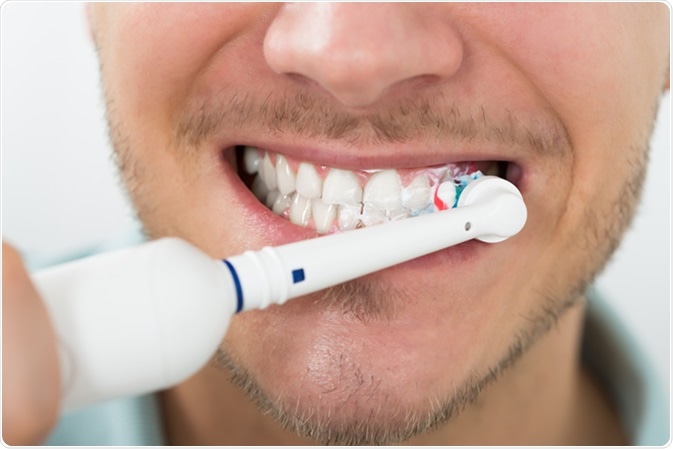Brushing teeth is an important part of dental hygiene. A regular routine for teeth care is necessary for maintaining good dental health. Normally dentists recommend that you brush your teeth twice a day. The duration of brushing should last two minutes and the toothpaste you use should contain fluoride. However, this does not answer a rather interesting question that has been debated fiercely online.

When Should You Wet Your Toothbrush?
A virtual war on micro blogging site Twitter has people arguing about the finer nuances of brushing teeth. More specifically, when you should wet your toothbrush while brushing your teeth. There is a school of thought which does not want to dilute the fluoride content in the toothpaste. They don’t want to wet the toothbrush at all. Neither before nor after applying the toothpaste to it.
Another group feels that the toothbrush needs to be cleaned with water before use. They reason that there may be bacteria build up in the bristles during the hours that it stood after being used last. Others report having seen cockroaches in the bathroom that may climb over the toothbrush at night. They insist that the toothbrush must be washed well and disinfected, before placing it in the mouth.
There are people who wet the toothbrush and then add the toothpaste. Then there are those who apply the toothpaste and then wet the toothbrush. There was even someone who preferred to wet the toothbrush, but squeeze the toothpaste directly on to the tongue. Needless to say, there are many people following all kinds of brushing etiquette, so what’s the right way to brush your teeth? What actually helps preserve the health of your teeth?
The Expert Opinion
Even expert opinion is divided when it comes to the ‘wet or dry’ toothbrush debate. Dr Nigel Carter feels that the most effective application is to not use water at all and use a pea-sized amount of toothpaste. As per Dr Carter, the water weakens the bristles and makes them less effective in cleaning teeth. He does recommend brushing for a full two minutes last thing at night. The right way to brush, as per Dr Carter, is to keep the toothbrush at a 45 degree angle to aid removal of food debris and bacteria from along the gum line.
Professor Damien Walmsley is a scientific adviser to the British Dental Association. As per Professor Walmsley, toothpaste is a means of getting fluoride on to the teeth. Fluoride helps to make the teeth more resistant to decay. What matters is that the fluoride comes in contact with the teeth, and a moist toothbrush is likely to make the experience of brushing your teeth more pleasant. Professor Walmsley recommends that a fluoride toothpaste should be used to brush the teeth twice a day. One of which should be the last thing at night.
Brushing advice from the American Dental Association is to brush your teeth twice a day. While opinion is divided about brushing before or after breakfast for the first time in the day, everyone agrees that the second time should be after you have finished dinner and are not going to eat any more. This makes sense because the bacteria build up will occur much faster if there are food particles in the mouth overnight.
Tips to Brush your Teeth
People still end up with tooth decay because they are not brushing their teeth correctly. Often children are not taught how to brush their teeth in a proper manner because their parents don’t know how to brush teeth properly either. The National Health Service, UK, has some advice about brushing.
- It doesn’t matter if you use an electric toothbrush or a manual one, as long as you brush your teeth for about two minutes.
- The toothbrush should have a small head and a compact arrangement of long and short bristles which are round ended.
- Brushing the last thing in the night is extremely important and the habit should be inculcated in children from the age of seven onwards.
- The toothpaste used should contain at least 1,350 parts per million fluoride. Check the packaging to see how much fluoride your brand of toothpaste contains.
- Children do not need to use a special children’s toothpaste. The regular one works fine for them. Just ensure that they use only a pea sized amount of toothpaste and don’t swallow it.
- While brushing your teeth, ensure that you brush the inside surface, outside surface and chewing surface of all the teeth.
- Once you finish brushing your teeth, spit out the excess toothpaste but try not to use too much water to rinse your mouth. This will wash away the fluoride coated on the teeth during brushing.
- After brushing don’t use mouthwash immediately. The fluoride from the toothpaste will wash away with the mouthwash gargle.
- Use a fluoride mouthwash about half an hour after you brush. Try not to eat or drink for half an hour after using mouthwash.
References
- http://www.bbc.co.uk/bbcthree/article/887fff56-925c-416e-bc15-fb173ecfda2b
- https://www.nhs.uk/Livewell/dentalhealth/Pages/Teethcleaningguide.aspx
- https://www.mayoclinic.org/healthy-lifestyle/adult-health/in-depth/dental/art-20045536?pg=1
- https://www.mouthhealthy.org/en/brushing-mistakes-slideshow
- https://www.nhs.uk/Livewell/dentalhealth/Pages/Keepteethhealthy.aspx
- https://www.nhs.uk/Livewell/dentalhealth/Pages/Careofkidsteeth.aspx
Further Reading
- All Teeth Content
- Dental Health in Children
- Foods Good for Teeth
- Tooth Polishing Procedure
- When Should Children Get Their Adult Teeth?
Last Updated: Aug 23, 2018

Written by
Cashmere Lashkari
Cashmere graduated from Nowrosjee Wadia College, Pune with distinction in English Honours with Psychology. She went on to gain two post graduations in Public Relations and Human Resource Training and Development. She has worked as a content writer for nearly two decades. Occasionally she conducts workshops for students and adults on persona enhancement, stress management, and law of attraction.
Source: Read Full Article
